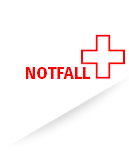For our patients
Dear Patient,
Here, you will find general information about the range of diagnostic and therapeutic neuroradiological services provided at the University Hospital Jena, Friedrich Schiller University. The following pages present the individual methods and procedures that are available.
Therapy focus
We have compiled an overview of our treatment focuses in this brochure. It aims to serve as a guide.
Examination methods
Here, we present a brief overview of some of the procedures and functions of the techniques and devices used in neuroradiology:
MRI - Magnetic Resonance Imaging
"Magnetic resonance imaging" (MRI or MR), also called "nuclear spin tomography", is a modern imaging modality that can produce high-resolution sectional images of the body. The major advantage of this method is that no X-rays are used, images can be made in any spatial axis, and the images provide a high-quality tissue contrast.
This technique requires radio waves and a strong magnetic field, usually up to 30,000 times stronger than the earth's magnetic field. MRI has been being used in medical diagnostics since the 1980s and is based on particular physical properties of hydrogen nuclei: in simpler terms, these atomic nuclei behave like small bar magnets (e.g., similarly small compass needles) that are normally oriented at random in the human body and therefore the tissue is not magnetic. If a strong, homogeneous magnetic field is applied from the outside (as with an MRI device, for example), these many small body magnets align themselves parallel to the external magnetic field. They can be stimulated by radio waves at a very specific frequency (the so-called "Larmor frequency") and then "betray" their exact position in the body. In a sophisticated process, high-resolution images of the brain are produced.
CT - computed tomography
Computed tomography (CT) is a modern computer-assisted X-ray examination. "Tomography" means "representation in layers or slices". With CT the human body can be depicted in thin slices and can be arranged together in any direction.
In contrast to a conventional X-ray examination, the body is continuously irradiated by an X-ray beam for a few seconds during a CT examination. The X-ray beam moves on a circular path around the patient, whereby the modern equipment simultaneously moves the examination table forward to produce a spiral scanning of the body portion being examined (termed "spiral CT").
The great advantage of this method is that it provides a nonoverlapping, continuous representation of the body section being examined and subsequently can calculate images in any directions. Another advantage of the method is the high speed of imaging compared to, for example, MRI. Within a few seconds, the entire examination is completed. A major disadvantage of CT is the radiation.
Angiography
Imaging of the arteries with the aid of a contrast agent is referred to as "angiography" (or "arteriography"). In angiography, a contrast agent is injected directly into the arteries and an X-ray is taken at the same time so that the vessels become visible on the X-ray image. Nowadays, "DSA angiography" is applied, a modern computer technology. The abbreviation "DSA" stands for "Digital Subtraction Angiography". In principle, an X-ray image without a contrast agent and an X-ray image with a contrast agent are acquired and "subtracted" from each other using computer-assisted technology so that ultimately only the vessels are seen on the image. It is important that the patient does not move between the two acquisitions.
The contrast agent is injected via a very thin tube known as a "catheter" directly into the vessel so that it arrives undiluted in the area being examined and thus can create the best image contrast. These catheters are inserted in the groin or the elbow artery after local anesthesia. The contrast agent is then passed into the blood via the catheter. At the same time a rapid series of x-ray images are taken (typically 6 images per second). For this procedure, iodine-containing X-ray contrast agents are normally used, which are very well tolerated.
X-rays
Conventional X-rays still represent a cornerstone in diagnostic imaging. In neuroradiology, for example, the bony spine is very often depicted using conventional X-rays. Today, these pictures are usually digitally stored and presented; "classic” x-ray films are no longer used in modern clinics.
X-rays are generated in an X-ray tube and constitute particularly high-energy electromagnetic waves that can penetrate the human body. In doing so, they are attenuated by the different body tissues to different degrees (for example, bones weaken X-rays more than muscle or fat tissue does). Subsequently, these differently weakened X-rays exit the body again and act on a radiation detector, which then stores the resulting attenuated image. This attenuated image is converted into the final "X-ray image" in a rather complex process.
Appointments can be arranged by calling the following telephone number:
Division head secretariat:
Tel.: +49 (0) 3641 9 324761
Fax: +49 (0) 3641 9 324762
Referrals are accepted from all practices, hospitals, polyclinics, and emergency departments. Of course, you can also be treated as a private patient.
Please adhere carefully to the medication prescribed by your neuroradiologist and do not discontinue medication without consulting the attending physician; otherwise, this can be fatal. If you do not tolerate your medication well, please discuss this with your doctor immediately, who can always consult with us.


